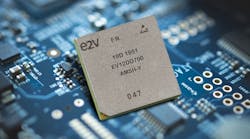Direct Microwave-Synthesis DAC Provides Ka-band Output
In its EV12DD700 dual-channel digital-to-analog converters (DACs), Teledyne e2v takes a step toward its goal of remaking the signal chain. Available now as beta samples, the EV12DD700 DAC is a wide-output-bandwidth (12 or 8 bits) that handles sampling rates up to 12 GS/s. It also has the capacity to generate signal waveforms over multiple frequency bands.
The distinguishing feature of the EV12DD700 is that e2v claims it as the first such device to support operation within the Ka-band (26.5 to 40 GHz). In addition, the device includes a number of features that include direct digital synthesis (DDS) and digital up-conversion (DUC) via a built-in 32-bit numerically-controlled oscillator (NCO). These facilitate greater throughput without putting excess strain on the IC’s resources.
Another key feature of the DAC is its high-speed serial interface based on the flexible, efficient, and simple ESIstream protocol. ESIstream is an open, highly efficient serial interface protocol based on 14b/16b encoding, with its main benefits being low overhead and ease of hardware implementation. Each DAC core can convert either real data from the 16 high-speed serial lanes (HSSLs) or complex data through their respective DUCs. Each functions of the DAC can be controlled through a Serial Peripheral Interface (SPI).
The device can be operated in different output modes with respect to the performance targeted over the full operating bandwidth. The -3dB bandwidth is 25 GHz for a direct signal synthesis without up-conversion stages in the RF front end. The appropriate output mode is selectable to achieve the best compromise between output power and dynamic range. NRZ/ RF and 2RF modes are used with a clock frequency signal up to 12 GHz and 24 GHz, respectively. The output gain is adjustable, and the output frequency response can be flattened by the anti-sinc function filter (ASINC).
In real data mode (no interpolation), the device synthesizes a very wide Nyquist zone or maximum instantaneous bandwidth of 6 GHz. Sixteen HSSLs at 12 Gb/s per DAC core funnel the digital data to the device.
In complex data mode, interpolation factors (by 4, 8, or 16) can be applied to one or both DAC cores to reduce the overall data rate and reduce the number of HSSLs. Innovative functions are available to control amplitude and phase delays as well as frequency in the digital data path. These functions, configurable through SPI, are beamforming, beam hopping (to hop up to 4 zones), fast frequency hopping, and DDS/chirp.
With EV12DD700 DACs as an option, Teledyne e2v points engineers toward creating next-generation RF systems that have much greater versatility. It will mean that RF system designs can incorporate cutting-edge digital functions such as fast frequency hopping (FFH) and beamforming. The envisaged software-based approach will allow configuration changes directly in code by configuring the DAC, rather than having the inconvenience and expense of making alterations to the hardware. Key applications will include radar, satellite communication, terrestrial network infrastructure, and so on.
Earlier this year, Teledyne e2v announced an EV12DD700-based evaluation board with which engineers could get a look at the device’s performance levels. Direct access to samples now lets them evaluate how the device will fit into their designs and begin to plan migration.
The new EV12DD700 DACs will be supplied in a Hi-TCE package format with dimensions of 20 mm x 20 mm. These robust ICs have a wide operational temperature range of -55°C to 125°C.
Teledyne e2v, www.teledyne-e2v.com

